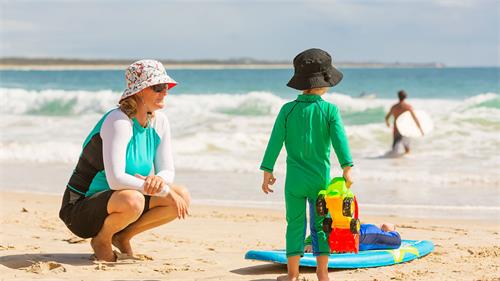






With warmer weather and sunny days upon us, outdoor activities become more enticing for families and children. However, along with the joys of outdoor fun, it's crucial to prioritize sun safety, especially for kids. Ultraviolet (UV) rays from the sun can cause immediate damage, such as sunburn, and long-term effects, including premature aging and an increased risk of skin cancer. Children are particularly vulnerable to these risks because their skin is more delicate and susceptible to damage.
Prevention Strategies:
Apply Sunscreen Regularly:
Opting for a broad-spectrum sunscreen rated SPF 30 or higher stands as a cornerstone in shielding children against detrimental UV rays. Ensure to generously apply sunscreen across all exposed areas—be it the face, ears, neck, arms, or legs—about half an hour before stepping outdoors. For sustained protection, remember to reapply sunscreen every two hours, or more frequently during water activities or instances of profuse sweating.
Seek Shade:
Minimizing direct exposure to sunlight during its peak intensity, generally occurring from 10 a.m. to 4 p.m., markedly diminishes the likelihood of sunburn and skin harm. Encourage children to engage in activities within shaded spots, such as beneath trees, umbrellas, or canopies. In instances where shade isn't accessible, contemplate crafting your shelter using portable umbrellas or sun shelters.
Dress Appropriately:
Clothing can provide an additional layer of protection against UV rays. Dress children in lightweight, long-sleeved shirts, long pants, and wide-brimmed hats that shade the face, neck, and ears. Opt for tightly woven fabrics that offer better sun protection. Sunglasses with UV protection are also essential to shield the eyes from harmful rays.
Stay Hydrated:
Spending time outdoors, especially in hot weather, can increase the risk of dehydration. Make sure children drink plenty of water throughout the day, even if they don't feel thirsty. Encourage frequent water breaks, particularly during outdoor activities, to prevent dehydration and overheating.
Educate About Sun Safety:
Teaching children about the importance of sun safety from an early age can help instill lifelong habits. Explain the risks of sunburn and skin damage in simple terms, and involve them in the process of applying sunscreen and seeking shade. Encourage them to take responsibility for their sun protection by reminding them to wear hats and sunglasses when playing outside.
Lead by Example:
Children learn by observing their parents' behavior, so it's essential to lead by example when it comes to sun safety. Make sun protection a priority for the entire family by practicing what you preach. Wear sunscreen, protective clothing, and sunglasses yourself, and seek shade when spending time outdoors together.
Be Mindful of Reflection:
Reflective surfaces such as water, sand, and concrete can amplify UV exposure, increasing the risk of sunburn. Take extra precautions when near these surfaces by applying sunscreen more frequently and seeking shade whenever possible. Consider using beach umbrellas or tents to create a shaded retreat.
Monitor Medications:
Some medications, including certain antibiotics and acne treatments, can increase the skin's sensitivity to sunlight, making children more prone to sunburn. Consult with your healthcare provider or pharmacist to understand any potential side effects of medications your child may be taking and take appropriate sun protection measures.
